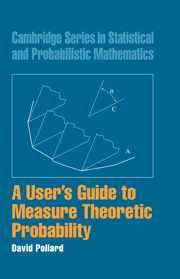Book contents
- Frontmatter
- Contents
- PREFACE
- CHAPTER 1 MOTIVATION
- CHAPTER 2 A MODICUM OF MEASURE THEORY
- CHAPTER 3 DENSITIES AND DERIVATIVES
- CHAPTER 4 PRODUCT SPACES AND INDEPENDENCE
- CHAPTER 5 CONDITIONING
- CHAPTER 6 MARTINGALE ET AL.
- CHAPTER 7 CONVERGENCE IN DISTRIBUTION
- CHAPTER 8 FOURIER TRANSFORMS
- CHAPTER 9 BROWNIAN MOTION
- CHAPTER 10 REPRESENTATIONS AND COUPLINGS
- CHAPTER 11 EXPONENTIAL TAILS AND THE LAW OF THE ITERATED LOGARITHM
- CHAPTER 12 MULTIVARIATE NORMAL DISTRIBUTIONS
- APPENDIX A MEASURES AND INTEGRALS
- APPENDIX B HILBERT SPACES
- APPENDIX C CONVEXITY
- APPENDIX D BINOMIAL AND NORMAL DISTRIBUTIONS
- APPENDIX E MARTINGALES IN CONTINUOUS TIME
- APPENDIX F DISINTEGRATION OF MEASURES
- INDEX
CHAPTER 10 - REPRESENTATIONS AND COUPLINGS
Published online by Cambridge University Press: 29 March 2011
- Frontmatter
- Contents
- PREFACE
- CHAPTER 1 MOTIVATION
- CHAPTER 2 A MODICUM OF MEASURE THEORY
- CHAPTER 3 DENSITIES AND DERIVATIVES
- CHAPTER 4 PRODUCT SPACES AND INDEPENDENCE
- CHAPTER 5 CONDITIONING
- CHAPTER 6 MARTINGALE ET AL.
- CHAPTER 7 CONVERGENCE IN DISTRIBUTION
- CHAPTER 8 FOURIER TRANSFORMS
- CHAPTER 9 BROWNIAN MOTION
- CHAPTER 10 REPRESENTATIONS AND COUPLINGS
- CHAPTER 11 EXPONENTIAL TAILS AND THE LAW OF THE ITERATED LOGARITHM
- CHAPTER 12 MULTIVARIATE NORMAL DISTRIBUTIONS
- APPENDIX A MEASURES AND INTEGRALS
- APPENDIX B HILBERT SPACES
- APPENDIX C CONVEXITY
- APPENDIX D BINOMIAL AND NORMAL DISTRIBUTIONS
- APPENDIX E MARTINGALES IN CONTINUOUS TIME
- APPENDIX F DISINTEGRATION OF MEASURES
- INDEX
Summary
SECTION 1 illustrates the usefulness of coupling, by means of three simple examples.
SECTION 2 describes how sequences of random elements of separable metric spaces that converge in distribution can be represented by sequences that converge almost surely.
SECTION *3 establishes Strassen's Theorem, which translates the Prohorov distance between two probability measures into a coupling.
SECTION *4 establishes Yurinskii's coupling for sums of independent random vectors to normally distributed random vectors.
SECTION 5 describes a deceptively simple example (Tusnády's Lemma) of a quantile coupling, between a symmetric Binomial distribution and its corresponding normal approximation.
SECTION 6 uses the Tusnády Lemma to couple the Haar coefficients for the expansions of an empirical process and a generalized Brownian Bridge.
SECTION 7 derives one of most striking results of modern probability theory, the KMT coupling of the uniform empirial process with the Brownian Bridge process.
What is coupling?
A coupling of two probability measures, P and Q, consists of a probability space (Ω, ℱ, ℙ) supporting two random elements X and F, such that X has distribution P and Y has distribution Q. Sometimes interesting relationships between P and Q can be coded in some simple way into the joint distribution for X and Y. Three examples should make the concept clearer.
Example. Let Pα denote the Bin(n,α) distribution. As α gets larger, the distribution should “concentrate on bigger values.” More precisely, for each fixed x, the tail probability Pα[x, n] should be an increasing function of α. A coupling argument will give an easy proof.
- Type
- Chapter
- Information
- A User's Guide to Measure Theoretic Probability , pp. 237 - 260Publisher: Cambridge University PressPrint publication year: 2001



